A toner cartridge is an essential component in laser printers, containing a powdered substance that facilitates the printing process through electrostatic imaging. These cartridges are specifically designed for various types of laser printers, including monochrome laser, color laser, and multifunction models. They are not compatible with inkjet or thermal printers. Understanding toner cartridges and their functionalities can help in selecting the appropriate option for individual printing needs, as further information will reveal valuable insights.
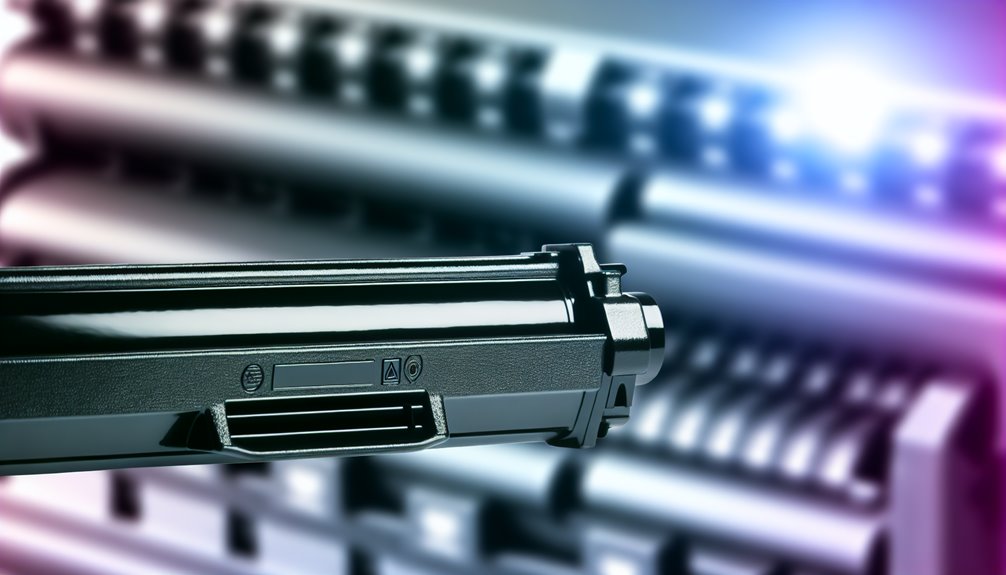
Understanding toner cartridges is vital as they serve as the primary medium for producing high-quality prints in laser printers.
Their effectiveness is essential across various sectors, including office environments, educational institutions, and commercial enterprises, where reliability and efficiency are paramount.
Why is it essential for users to grasp the functionality and compatibility of toner cartridges within laser printers? Understanding toner cartridges is critical for optimizing toner efficiency and ensuring maximum cartridge lifespan.
Users must recognize the significance of selecting compatible cartridges to achieve print consistency, which directly impacts document quality. Additionally, knowledge of toner types aids in evaluating cost effectiveness; high-yield toner cartridges reduce long-term expenses, particularly in high-volume printing environments.
Moreover, awareness of toner recycling options promotes sustainable practices, minimizing environmental impact. Mastering these aspects empowers users to enhance their printing operations, ensuring they effectively leverage the capabilities of their laser printers while minimizing costs and waste.
Toner cartridges play a pivotal role in office, educational, and commercial environments, serving as the backbone for efficient document production. Their significance is underscored by various factors:
These elements demonstrate the integral function of toner cartridges in modern printing landscapes.

A toner cartridge serves as an essential component in laser printers, housing a mixture of plastic particles, carbon, and coloring agents in the form of toner powder.
These cartridges are primarily available in four toner types: black, cyan, magenta, and yellow, facilitating a range of color accuracy in printing.
The cartridge lifespan considerably exceeds that of ink cartridges, typically yielding up to 50,000 pages, which can lead to lower overall printing costs for high-volume users.
Effective maintenance tips include monitoring toner levels and replacing cartridges as print quality declines.
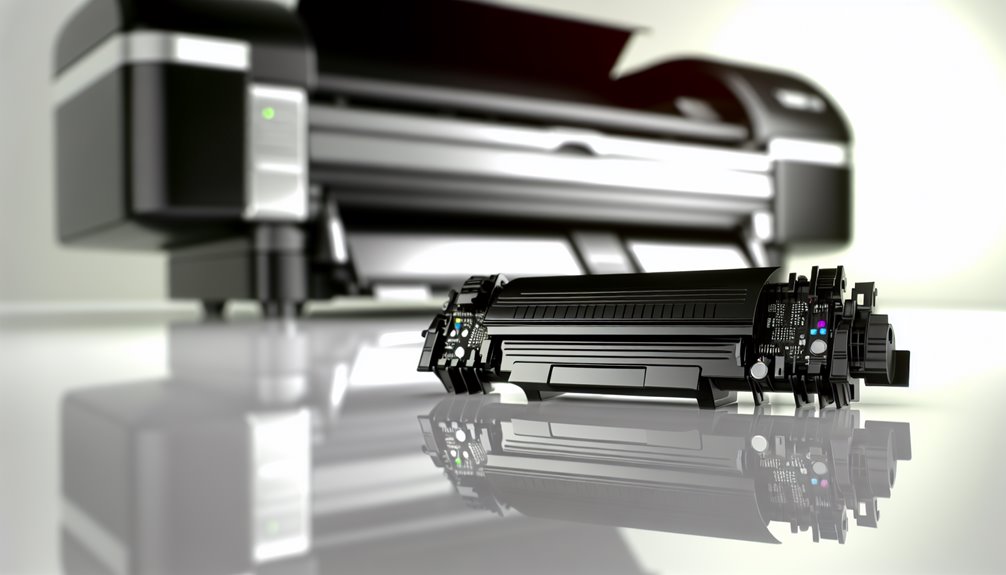
The operation of a toner cartridge involves a sequence of processes including electrostatic imaging, transfer, and fusing to achieve print output.
In color printing, multiple toner cartridges work in concert to produce a full spectrum of colors, while monochrome printing relies solely on a black toner cartridge.
Additionally, the design of toner cartridges can vary, featuring either integrated drum and toner systems or separate components, influencing maintenance and performance.
Utilizing a systematic approach, laser printers employ a three-step process to produce high-quality prints: electrostatic imaging, transfer, and fusing.
This method leverages advanced toner technology to enhance printing efficiency and cartridge lifespan while considering environmental implications.
This process supports sustainable practices by reducing waste compared to inkjet alternatives.
Through this meticulous process, laser printers achieve superior results, aligning with the demands of high-volume printing environments.
Color and monochrome printing represent two distinct methodologies in the utilization of toner cartridges, each tailored to specific printing needs.
Color printing techniques employ multiple cartridges—cyan, magenta, yellow, and black—to produce a broad spectrum of hues, which can lead to color accuracy issues depending on the printer's calibration.
In contrast, monochrome printing advantages include lower operational costs and higher print efficiency, as only black toner is utilized, reducing material expenses.
The print resolution differences are notable; monochrome prints typically achieve sharper text clarity, while color prints excel in vibrancy.
A cost comparison analysis further reveals that monochrome printing is generally more economical for high-volume documents, making it a preferred choice for businesses focused on efficiency and budget management.
Integrated and separate drum and toner designs represent two fundamental approaches in toner cartridge technology, influencing print quality, maintenance, and overall printing efficiency.
These distinctions play a significant role in determining the suitability of a cartridge system for varying printing needs and operational environments.

Toner cartridges are exclusively utilized in laser printers, encompassing monochrome laser, color laser, and multifunction laser printer models.
These cartridges are engineered for high-volume printing and are not compatible with inkjet or thermal printers.
Understanding the specific printer types that use toner cartridges is essential for ensuring peak performance and print quality.
Monochrome laser printers are specifically designed to utilize black toner cartridges, providing an efficient solution for high-volume printing needs.
These printers excel in monochrome printing, delivering sharp text and graphics with rapid print speeds.
Key features include:
Monochrome laser printers are therefore a preferred choice for environments requiring reliable and economical printing solutions.
Color laser printers are specifically engineered to utilize multiple toner cartridges—typically four—that correspond to the primary colors: cyan, magenta, yellow, and black (CMYK). This configuration enhances color accuracy through effective color mixing, allowing for vibrant and precise print quality.
The toner cost is often higher than that of inkjet cartridges; however, color laser printers provide a superior cartridge lifespan, often yielding thousands of pages before replacement is necessary. This longevity contributes to lower total costs for high-volume printing environments.
Additionally, the ability to produce consistent, high-quality prints makes color laser printers ideal for businesses aiming to deliver professional documents and marketing materials while maintaining efficiency in production.
Multifunction laser printers (MFPs) represent a versatile solution in modern printing technology, combining multiple functionalities such as printing, scanning, copying, and sometimes faxing within a single device.
These printers utilize toner cartridges, offering several advantages:
While many printers utilize various types of cartridges, toner cartridges are specifically designed for laser printers and are not compatible with inkjet or thermal printers. This incompatibility arises from the distinct operational mechanisms; toner cartridges employ dry powder, while inkjet printers rely on liquid ink.
Printer compatibility issues can lead to less-than-ideal performance and increased costs when mismatched cartridges are used. To guarantee ideal functionality, users should adhere to cartridge maintenance tips, such as regular cleaning and monitoring toner levels.
Additionally, understanding toner shelf life is essential, as expired toner can affect print quality. Finally, engaging in environmental recycling practices for used toner cartridges contributes to sustainability efforts by reducing waste.
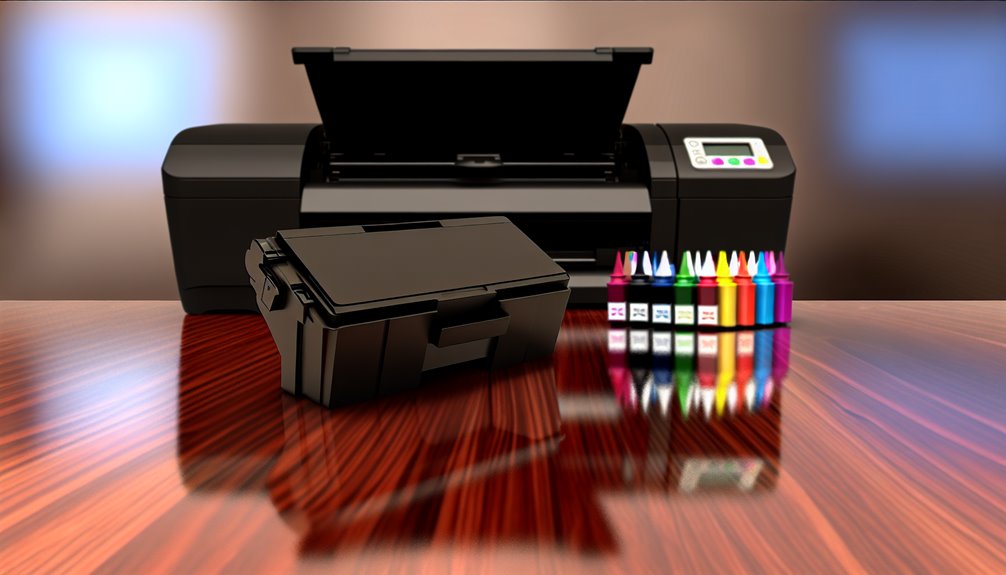
Toner cartridges and ink cartridges serve distinct roles in the printing ecosystem, each tailored to specific printing technologies and needs. The differences between them substantially impact toner efficiency, ink longevity, and overall printing costs.
Understanding these differences can aid in selecting the appropriate solution for specific printing requirements.
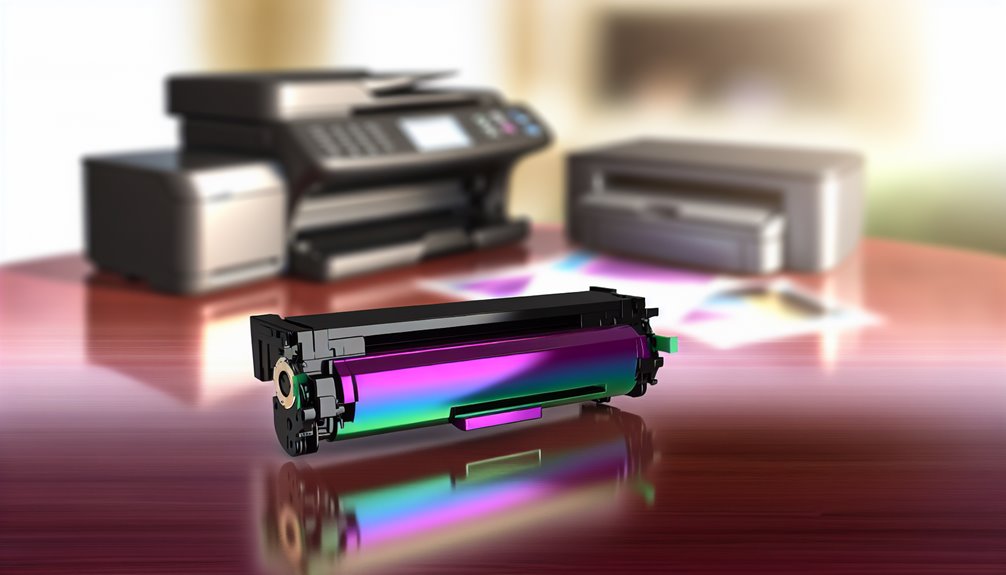
Toner cartridges are particularly suited for offices and business environments where high-volume document printing is essential, as they provide a cost-effective and efficient solution.
Educational institutions also benefit from their longevity and ability to produce clear, sharp text for educational materials.
Additionally, occasional users may find toner cartridges advantageous due to their non-drying nature, ensuring consistent performance even with infrequent use.
In environments where high-volume printing is essential, offices and business users greatly benefit from utilizing toner cartridges.
These cartridges enhance office efficiency by delivering rapid print speeds and high-quality output, directly impacting productivity. They also contribute to reduced printing costs over time due to their extensive cartridge lifespan and lower frequency of replacements compared to ink cartridges.
Key advantages include:
When considering printing solutions for schools and educational institutions, the efficiency and reliability of toner cartridges emerge as a superior option for high-volume printing needs.
Schools often operate under stringent budgets and require adherence to specific printing policies; therefore, the toner efficiency of laser printers facilitates cost-effective operations.
With substantial page yields, toner cartridges minimize the frequency of replacements, which is advantageous for maintaining classroom technology and ensuring uninterrupted access to educational resources.
In addition, the superior print quality of toner cartridges supports the production of clear and professional-grade materials, essential for academic environments.
Consequently, adopting toner cartridges aligns with the objectives of optimizing resource allocation while enhancing educational outcomes.
High-volume document printing users benefit greatly from the efficiency and performance of toner cartridges.
These users, often in businesses and organizations, require solutions that guarantee high-quality output while managing costs effectively.
Toner cartridges excel in this environment due to several key factors:
Occasional users of laser printers find toner cartridges particularly advantageous due to their non-drying nature, which allows for infrequent usage without compromising print quality.
The toner longevity benefits stem from the unique toner powder composition, which remains stable over time, unlike liquid ink. This characteristic enables users to maintain print quality without the need for frequent replacements.
Various toner cartridge types, including monochrome and color options, cater to diverse printing needs while ensuring laser printing efficiency.
Additionally, a cost comparison reveals that while initial investments in toner cartridges may be higher, their extended yield and durability result in lower long-term costs, making them an ideal choice for users who print sporadically but require dependable, high-quality output.
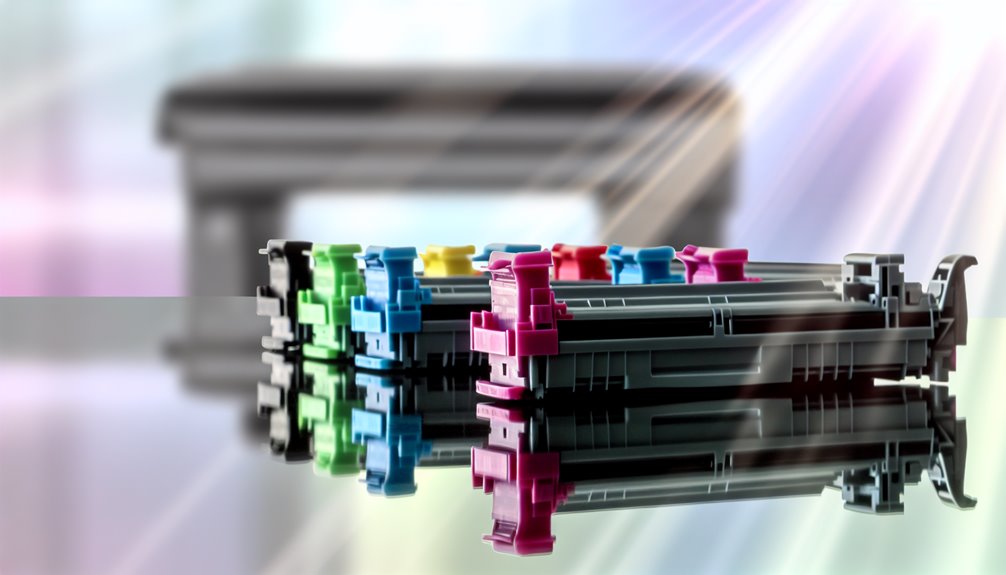
Choosing the right toner cartridge requires careful consideration of printer model compatibility, as each printer is designed to work with specific cartridge types.
Users must evaluate whether to select Original Equipment Manufacturer (OEM), compatible, or remanufactured cartridges based on their printing needs and budget constraints.
Additionally, attention should be paid to page yield ratings to guarantee that the chosen cartridge meets the volume requirements for efficient printing.
How can one guarantee compatibility between a toner cartridge and their laser printer model? Ensuring the correct toner cartridge types align with the printer model is essential for ideal performance. Compatibility can be verified through the following steps:
Understanding these factors enhances the toner cartridge lifespan and overall printing efficiency, ensuring high-quality outputs without damaging the printer.
When determining the ideal toner cartridge for a laser printer, it is essential to evaluate whether to select an original equipment manufacturer (OEM), compatible, or remanufactured cartridge.
OEM cartridges, designed specifically for a printer model, offer superior quality assurance and reliability. In contrast, compatible cartridges can provide cost savings but may compromise print quality or reliability.
Remanufactured cartridges, having been recycled and restored, offer an environmentally friendly option and can deliver comparable performance to OEMs, often at a reduced price.
A cost comparison reveals that while OEMs are generally more expensive, the long-term investment in quality may offset the initial savings of compatible and remanufactured cartridges.
Environmental considerations also play a role, as remanufactured options reduce waste considerably.
Page yield ratings represent a significant factor in selecting the appropriate toner cartridge for a laser printer. Understanding these ratings is essential for achieving ideal cost efficiency and cartridge longevity. High page yield not only reduces the frequency of cartridge replacements but also enhances overall printing speed.
Consider the following when evaluating page yield:

Although the process of installing and maintaining toner cartridges may appear straightforward, it requires careful attention to detail to guarantee peak printer performance. Proper toner cartridge cleaning techniques, such as using a lint-free cloth, can help mitigate common toner issues, including streaking and fading. Additionally, adhering to toner storage tips, such as keeping cartridges in a cool, dry place, can extend their lifespan. Users should regularly check toner levels and replace cartridges based on usage. Engaging in toner recycling programs can promote sustainability. The following table summarizes essential maintenance practices:
| Maintenance Task | Frequency | Benefits |
| Cleaning cartridge | Every 3 months | Prevents clogs |
| Checking toner levels | Monthly | Guarantees ideal printing |
| Recycling old cartridges | As needed | Reduces environmental impact |
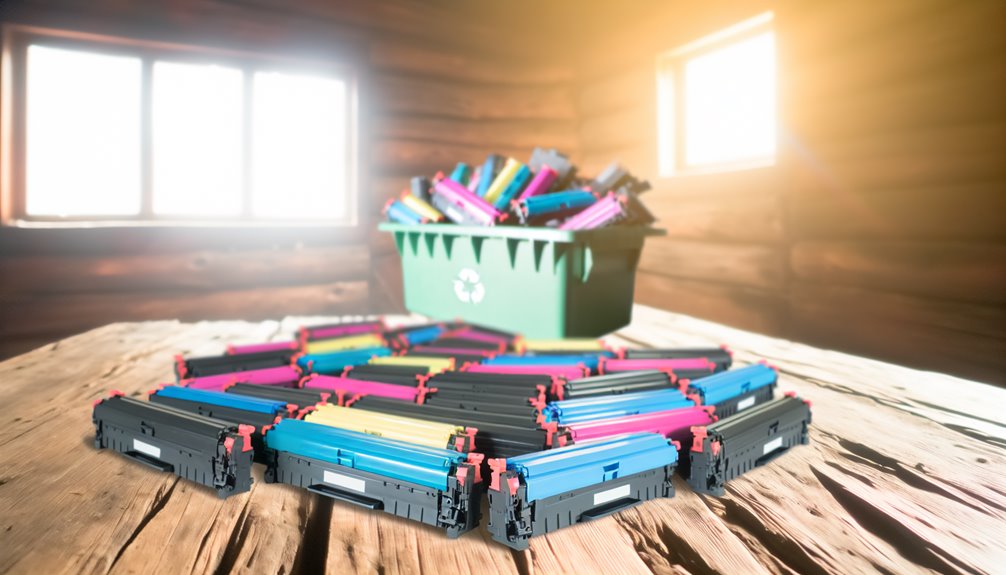
The environmental impact of toner cartridges is a significant consideration in the printing industry, particularly as organizations endeavor for sustainability. Effective toner recycling and responsible cartridge disposal are essential for minimizing ecological footprints.
Companies are increasingly adopting eco-friendly practices that align with waste reduction strategies. Key factors include:
Toner cartridges can be refilled, offering cost savings and reduced environmental impact. The refill process involves careful handling and DIY tips to guarantee proper toner application, consequently maintaining print quality and cartridge longevity through effective reuse.
Amidst the ticking clock of technology, toner cartridges possess a shelf life of 24-36 months. Proper toner storage mitigates performance degradation, while mindful disposal addresses environmental impact, transcending mere expiration dates for sustainable practices.
Low toner levels can be identified through toner level indicators on the printer, which provide critical cartridge replacement signals. Regular printer maintenance tips and troubleshooting printing issues enhance understanding of ink usage for ideal performance.
Toner compatibility issues arise due to printer brand differences and specific toner cartridge features. Cross brand usage is limited, influenced by toner technology evolution, necessitating careful selection to guarantee peak performance and print quality.
Toner cartridges typically include warranty coverage determined by manufacturer policies, offering guarantee durations that vary. Consumers should review return options and understand replacement procedures to guarantee satisfaction and address potential defects efficiently.
In summary, understanding toner cartridges and their compatibility with laser printers reveals a surprising interconnectedness in the printing world. As businesses and educational institutions increasingly rely on efficient printing solutions, the choice between toner and ink cartridges becomes critical. Coincidentally, those who opt for toner cartridges often find themselves benefiting from superior longevity and print quality, inadvertently shaping their operational efficiency. Consequently, selecting the right toner cartridge not only enhances print performance but also aligns with sustainable practices through responsible recycling efforts.